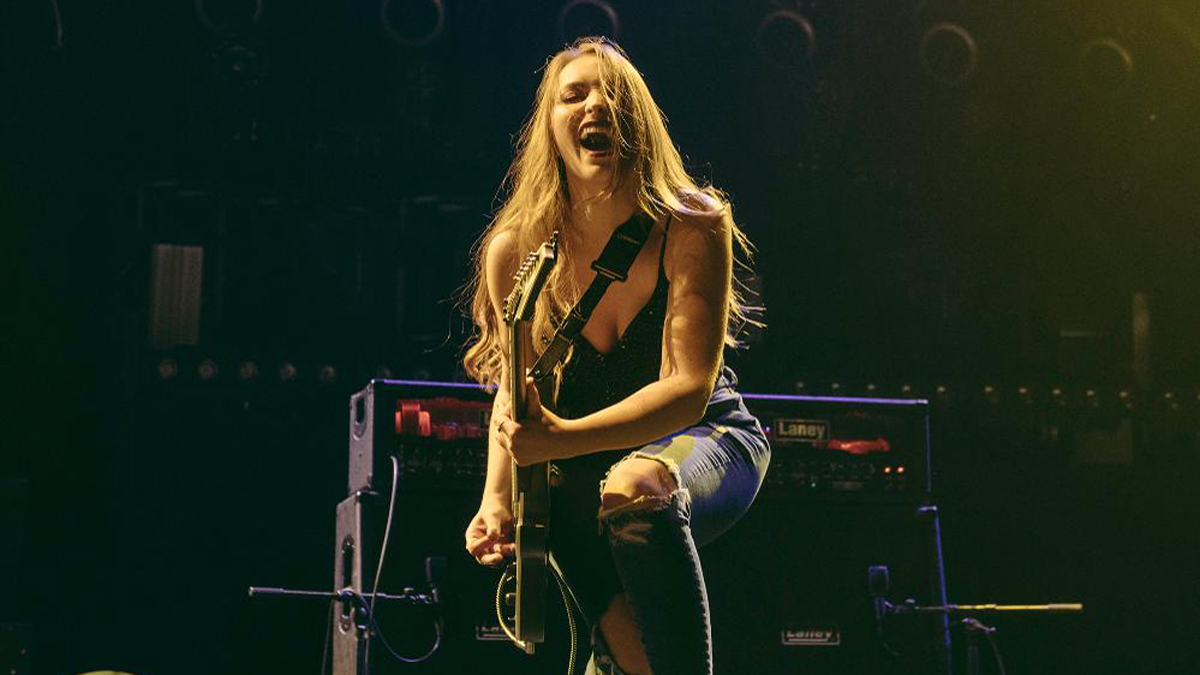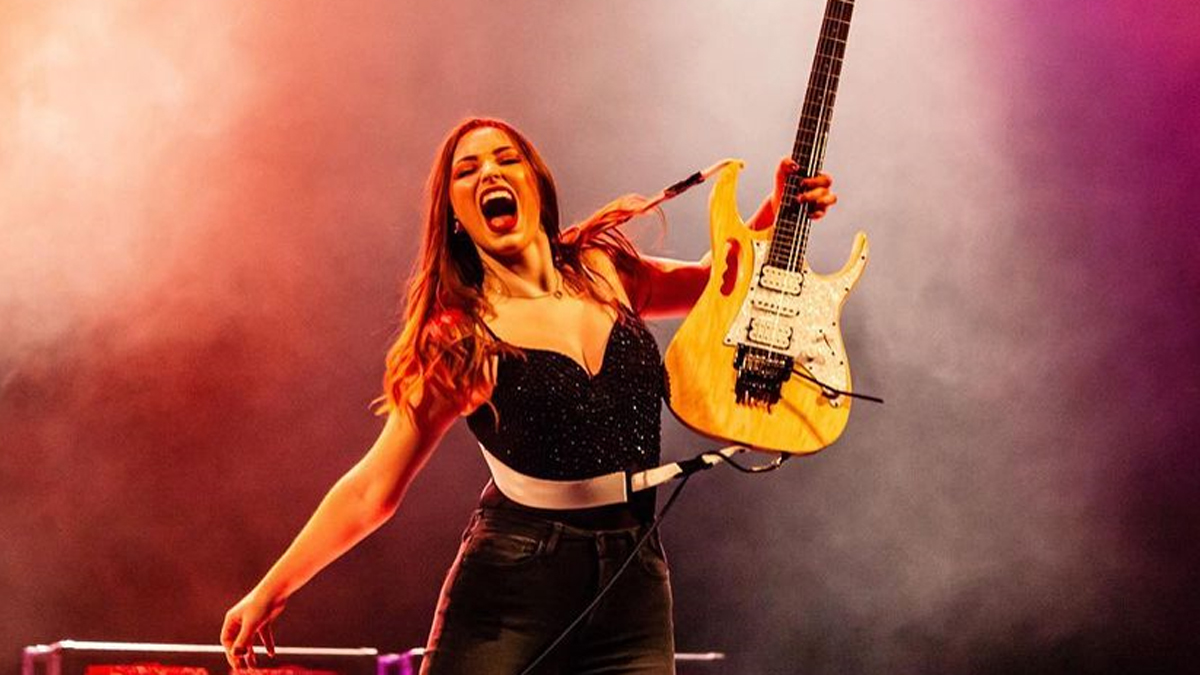Plush's Bella Perron: "It's important to study styles you wouldn’t normally gravitate to – it can give you a broader outlook on playing"
As she kickstarts a tour with Slash, the Berklee-schooled Ibanez endorsee discusses her band's rapid rise, playing with Evanescence and Halestorm, and her advice for aspiring guitarists

Bella Perron is an Ibanez artist receiving accolades from rock fans and idols alike, thanks to a six-string style characterized by speed, melodicism and feel. Satriani-esque in her approach, Perron's playing is as technical as it is vocal, and has so far attracted the plaudits of Slash, Halestorm and Evanescence.
She studied at the coveted Berklee College of Music, and spent her time refining her craft among some of the industry's finest. Far from being a rock-only guitarist, though, her versatility spans both genres and generations, with Perron covering everything from Metallica to Bach's Gigue Violin Partita No. 2.
It's this versatility that shines in all-female rockers Plush, where Perron handles lead guitar. Their first single, Hate, shot to Number 24 on Billboard Rock Charts, while a video of the band visiting the Musonia School of Music will be displayed in the Randy Rhoads Exhibit at the Rock & Roll Hall of Fame.
It's been a whirlwind few years for Perron and Plush, and it's set to get even busier: this month, the group hit the road with rock 'n' roll royalty Slash featuring Myles Kennedy and The Conspirators for their February US tour.
You get the picture: Bella Perron's heartening career as a player has only just begun, and yet she's already setting off a chain reaction of many young female rockers to come.
There are so many exciting things happening in your world right now. You are in Plush, an all-female rock band rapidly growing in popularity. You’re new on the scene, yet already opening for acts like Evanescence and Halestorm. What is it like playing those shows?
"It’s been an insane year for Plush and I’m so grateful for all of the amazing opportunities we’ve had. We had so much fun touring with Evanescence and Halestorm. It was surreal to be opening for two bands that have had such a huge influence on us.
Get The Pick Newsletter
All the latest guitar news, interviews, lessons, reviews, deals and more, direct to your inbox!
"We really try our best to put everything we have into our shows. It feels incredible to play live as a new band and have such a great response from crowds who have likely never heard of us."
Who are your main influences as a guitarist when it comes to your tone, phrasing, and overall sound?
"My main influences are Randy Rhoads, Joe Satriani, Joe Perry, Nuno Bettencourt, Ace Frehley, Eddie Van Halen, Slash, and Steve Vai. My overall sound and tone is heavily influenced from that era of rock. '70s and '80s rock was what I grew up listening to, but as I got into middle and high school I got into newer music, like Alter Bridge and Halestorm; I think you can really hear that more modern influence on the new album.
"My biggest influences when it comes to phrasing specifically are Joe Satriani, Slash and Randy Rhoads. I love how they all seamlessly blend melodic playing with complex licks, making every solo have such a unique character.
"That being said, when I was studying at Berklee my private instructor suggested that I study Bach violin sonatas, and this totally expanded my view on phrasing. I think it's important to branch out and study styles that you wouldn’t normally gravitate to, because it can give you a broader outlook on playing."

What does your live rig look like at the moment?
"I like to keep my live rig really straightforward. For my amp, I always use my Laney IRT120H half stack. On my pedalboard, I have the Boss GT-1000 and DigiTech Drop. For guitars, I’m currently using the Ibanez RG60ALS, RG652AHM, and RG420HPFM."
What’s a rule for practicing that you live by?
"To always try to push myself out of my comfort zone. It changes pretty frequently what I’m studying, but I strive to always push myself outside of playing what feels comfortable in order to grow as a guitar player.
"For me, this is usually done by transcribing solos, practicing improvising, or sight reading Real Book standards. I feel that it’s important to play, or work towards playing, something that pushes you outside of your comfort zone every day."
You’re an endorsed Ibanez artist. If you could design your own custom guitar, what features would you want it to have?
"It’s a dream come true to be an Ibanez artist. If I had my own custom guitar, I would want it to be an RG body with a Super Wizard neck. I’d love to have a mahogany body with a maple top, as well as a maple neck with an ebony fretboard, and the Tree of Life inlay.
"Ibanez's Edge tremolo is also a necessity for me since I use my whammy bar all the time. I would also likely go with the Seymour Duncan JB and Jazz pickups, which add so much warmth to the tone while also being super-versatile.
"As for finishes, I love the iconic look of sunburst guitars, so I would want a vibrant 'burst."
You collaborated with musicians during your time at Berklee. What is your advice to young musicians trying to seize opportunities in a world of haters, setbacks and competition?
"My biggest piece of advice is to reach out for any potential opportunity, because you never know where it can lead. I first heard of Moriah [Formica, Plush singer] and the band she was putting together because I came across her advert on Instagram.
"For a second I hesitated to reach out, but I’m so glad I did: a year and a half later we’ve just released our first album and are touring the country. Before Plush, I played anywhere I could: I would play in my school’s jazz band, at the local theater pit bands, in my dad’s cover bands, and I even played in a backing band for an elementary school choir.
"These opportunities pushed me to become a more well-rounded player and gave me experience performing in different settings. As far as haters, setbacks and competition, the best thing to do is to keep your eye on your goals and focus on what actions you can take to make progress towards your goals. Try to view competition as inspiration to continue pushing yourself.
"At Berklee, I was intimidated by my classmates and how insanely talented everyone was. Although I felt insecure about my own playing at times, this ultimately pushed me to practice even more. I grew so much as a guitar player and overall musician because of this."
A post shared by Bella Perron (@bella.perron)
A photo posted by on
What are your goals as a guitarist, and have you faced any obstacles as a young woman in the music industry?
"My goals as a guitarist are to continue honing in on my craft, creating original music and performing live. I feel most comfortable on stage, so my ultimate goal is to be able to travel the world on tour.
"I’d say that I’ve faced about the same number of obstacles as most male guitar players. The only difference is occasionally I’ll hear sexist remarks, or, more commonly, read them online. I do my best to ignore them since most of the time they are stemming from deeper sexist views rather than what I’m specifically doing. Female representation in the music scene really does matter.
"I think a huge reason why I’ve experienced sexism pretty mildly is because there are so many more women in the industry now compared to the scene 10 years ago. Having more female representation in this industry, which has been historically male-dominated, is one of the most effective ways to battle sexism.
"If one person feels confident or inspired to chase their dreams because of me then I am absolutely honored to have made a positive impact. That’s one of my favorite things about music: it can have such a powerful meaning and positive influence."
- For more from Bella Perron, check out her Instagram account, Twitter page, and Plush's YouTube channel.


![[from left] George Harrison with his Gretsch Country Gentleman, Norman Harris of Norman's Rare Guitars holds a gold-top Les Paul, John Fogerty with his legendary 1969 Rickenbacker](https://cdn.mos.cms.futurecdn.net/TuH3nuhn9etqjdn5sy4ntW.jpg)







